Posted in Blog, Create, Facilitation, Grow, Lead by Jo North
Become the BEST Creative Facilitator that You Can Be!
Welcome to my Facilitation Masterclass!
Facilitation is a Blend of Science, Art and Craft.
To become the best creative facilitator that you can be, it’s important that you continuously develop your knowledge and understanding of the science, art and craft of business innovation and group facilitation. It’s also essential that you are able to put this knowledge and understanding into practice when you go live with your workshop delegates.
This Facilitation Masterclass – Develop Your Authentic, Signature Facilitation Style – is one that I created for my Idea Time Facilitation Academy members, and I wanted to share it with you too.
Download the free playbook that goes with this Facilitation Masterclass, and use it for your own notes as you work through the videos that accompany the programme. I really hope you enjoy it and find it useful.
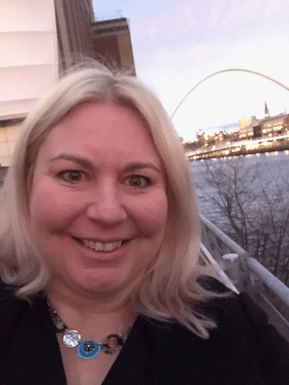
Many of my other articles can really help you with this, especially Creative Facilitation – An Introduction, Your Awesome Preparation Checklist, How to Facilitate Different Perspectives and Challenging Conversations and Insights into Group Dynamics for Facilitators.
The most successful workshop facilitators build on all their knowledge, understanding and practice, taking their impact to the next level by infusing their facilitation with their own authentic signature style. This has the extra benefit of helping them to lead the room in a state of flow, heightening the service and experience they create for their delegates.
How to achieve facilitation mastery
Such a level of facilitation mastery takes time, practice, focus and a growth mindset. The more you facilitate, the more you learn what works and doesn’t work for you. Working at the edge of, or a little beyond your comfort zone helps you to grow, too. Plus, great intuition helps significantly.
“If you feel safe in the area you’re working in, you’re not working in the right area. Always go a little further into the water than you feel you’re capable of being in. Go a little bit out of your depth. And when you don’t feel that your feet are quite touching the bottom, you’re just about in the right place to do something exciting.”
Here is how you can take your facilitation skills to the next level, once you have nailed the fundamentals of meeting or workshop facilitation.
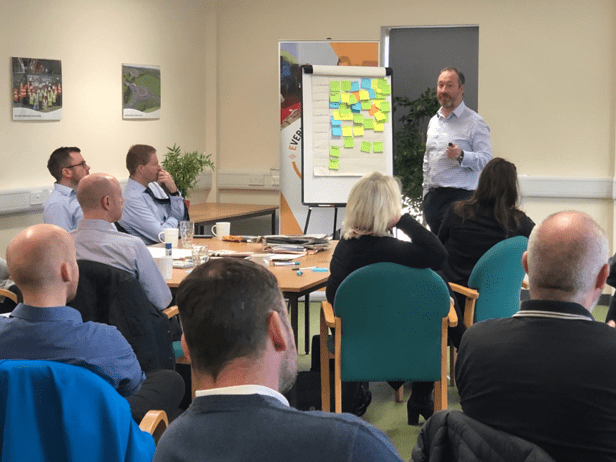
Two opposing truths
I think there are two opposing truths that are at the heart of facilitation mastery. These opposing truths are:
- The greatest facilitators have heightened levels of self-awareness; and
- The greatest facilitators focus on the people in the room, and not on themselves, working in a state of flow. They are’ un-self-conscious’.
When you are facilitating, you need heightened self-awareness to make sure that your impact on the people in the room, and on the outcomes of the event, are in line with what you want them to be. You need to be checking in with yourself mindfully to connect with your emotions and your state – i.e. how you’re feeling – to make any adjustments you need to your behaviour, language and decision-making.
![]()
But at the same time, it’s important that you don’t focus on yourself. You need to be super tuned into your delegates, reading where they are at and why. Your role is to help them to successfully collaborate and navigate through the process and contents of your event to achieve the end goal, whilst having a positive, motivational and appropriately stretching experience, too.
These two opposing truths sound challenging on their own, never mind in combination, don’t they? The good news, though, is that there is a pathway to developing this more advanced facilitation competence and expertise.

Know yourself
Knowing yourself as a workshop facilitator is absolutely essential. You need to know, for example:
- What makes you tick
- When you are at your best / most mediocre / worst, and why
- How to ‘reset’ your thinking when it’s not working well for you
- What things ‘trigger’ an emotional response from you – either positive or negative, and why – plus strategies for managing yourself appropriately
- Your preferences when it comes to working with others, communicating, decision-making, ways of working and processing information
These are just a few items.
Why self-knowledge is important
This sort of self-knowledge is important because in addition to helping you to manage yourself when you’re facilitating, it also raises your awareness of any biases or preferences that you have when it comes to content design and workshop processes. You can make sure that you design your event for others, and not just for yourself. You will be mindful of any potential blind-spots that you might have, and make efforts to overcome them, or work with others who complement your skills and preferences.
The fundamental necessity for self-knowledge works at both a macro-level (i.e. what you are like, and what you prefer in general overall as a person) and at hundreds of micro-moments when you’re actually performing live in an event, mindfully tuning in to your feelings, mindset, impact, actions and responses.
Your Authentic, Signature Facilitation Style
Your ‘authentic signature style’ is a combination of how you see yourself and how your delegates, clients, colleagues and others see you. And even if you think you haven’t got an authentic signature style, you have!
Whether we intend to or not we are always communicating and people are always reading us. So it’s really good to be intentional about your signature style and take a bit of time to think through whether how you’re being perceived is how you want to be perceived, is the style working for you, or is there anything that you want to change up, try out, or build on.
So, your signature facilitation style is how you show up, which influences to an extent how others see you and the experiences that you co-create with your delegates.
Your signature style is what makes you stand out – your differentiators, unique selling point or even competitive edge. It’s your personal brand of facilitation. I like what Jeff Bezos said about personal brand – it’s actually what people say about you when you leave the room.
Now, before we go any further, I just want to say a few words on authenticity, because of course this masterclass is about your authentic signature style. Obviously, a reality check is that most of us are not 100% authentic 100% of the time, because there are times when it’s healthier and better for us to put on an act to get through a situation. Hopefully that’s the exception rather than the norm, but the important point is that if you’re comfortable just being yourself, bringing your whole and best self to the room when you facilitate, this will create better impact, results and engagement than either not being fully present or by trying to be someone you’re not.
I will be using the metaphor of a tree for your facilitation signature style.
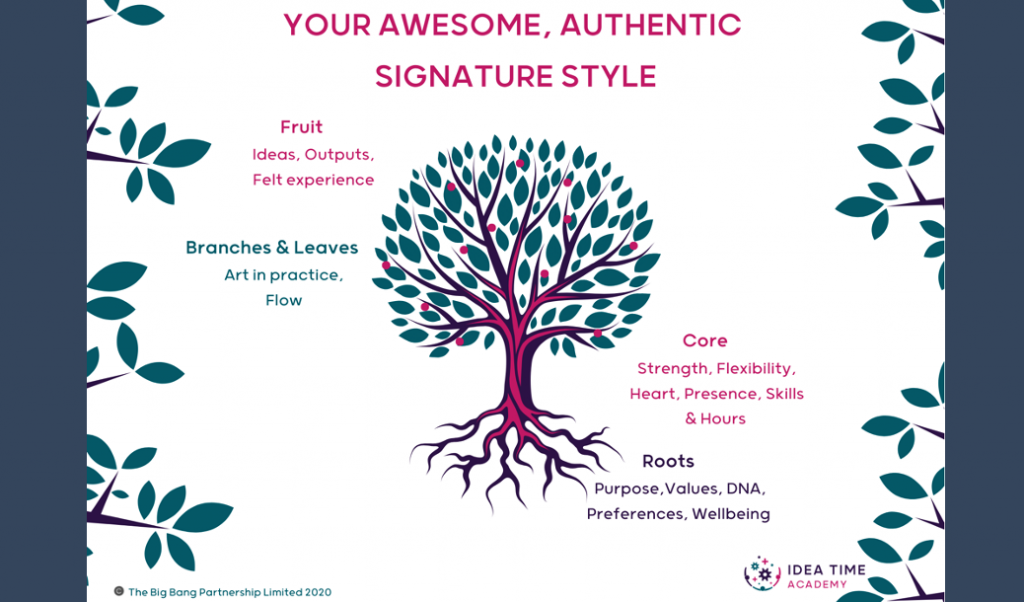
Just as a tree has roots, your facilitation style has roots too. Your roots include your purpose, values, DNA, preferences and wellbeing. These things really keep us grounded. They are absolutely fundamental to who we are.
The trunk of the tree represents your core. It’s your centre. Your strength, flexibility, heart, presence, skills and hours of practise all make up your core.
The branches and leaves represent when you are actually practising facilitation. When you’re in the moment, making your difference, in the flow. When you’re in the zone interacting with delegates to achieve the create the fruit – the ideas, outputs and experience that delegates feel that they are getting.
And even though when you facilitate, you are usually neutral and independent, when you facilitate as a service to your delegates from the inside out, you can reach people, connect better and have more useful outcomes, because you are bringing your whole, best self into the room.
Your whole and best self is something that you need to be continuously developing. It doesn’t matter if you’re a first-time facilitator or like me. I’ve been facilitating in different guises for over 20 years
We can always be learning. We always need to be evolving and we always need to be mindful of what we are doing, because if you’ve been doing facilitation for a long time, it’s so easy to get comfortable or complacent and slip from always doing our best work. If you’re a beginner facilitator, it’s never too soon to start thinking about your awesome authentic signature style. It will actually help you and accelerate your skills development, as well as helping you make a better and more meaningful impact in your events. It is very likely that your style will evolve over time, too, as you learn, experience more and grow. The bottom line is that it’s never too soon and it’s never too late to work on your signature style.
There are five activity sessions in my free download that accompany the videos in this blog.
In session one you’re going to explore a bit more what the term ‘signature facilitation style’ means and why it’s important. In a few seconds you’re also going to think about how you would define your own signature style.
Session two is about your roots – purpose, value, strengths, well-being – with some activities for you to think about those for yourself.
In session three you’ll work on developing your core – strengths, heart, flexibility, presence, skills and experience.
Session four is all about developing flow – the branches, leaves and fruit.
In session five – putting it all together – your awesome authentic signature facilitation style – you will define your style and create an action plan for growth.
The sessions are really short, but actually when you do your activities, I suggest that you give yourself a bit of time, make a cuppa and remember that there is no rush. Don’t feel like you’ve got a go through them all and complete them in one go. You don’t. This material is here for you – it maybe that you do one every couple of days or even one a week. That’s absolutely fine. In fact, putting a little bit of time, maybe a few hours at least, between each session could help you to mull over some of the themes.
Right, I promised you some activities! The first three activities that you’ll find in your will help you to begin to define your authentic signature facilitation style.
Facilitation Masterclass: Session 1
I’d like you to think about your own perceptions, and also any feedback or info that you’ve had from colleagues, delegates, clients and so on and just write down all those words that come to mind.
Get as many words out there as you can. Maybe even create a word cloud! The important thing is to write them all down. Just go big and get a good volume of words out there.
When you’ve done that, identify clusters of words or themes that stand out to you. What are the most recurring themes? Which words, or combination of words, show your uniqueness? Write these down, then go onto the next activity for this session.
The next step is to work through your facilitation growth plan. This has 12 prompts to help you explore how you’re feeling about your facilitation right now. They cover a range of different facilitation dimensions – for example, the range and diversity of your toolkit of processes and techniques, your experience, your well-being at work, how happy you are with your network of other facilitators and so on. For each of the statements, decide whether you’re taking your first steps, are on your way, doing okay, strong or super strong. Mark that down on the page – you can add in dots, or colour in the segments – whatever you want to do is fine, there is no right or wrong way, and this is your plan.
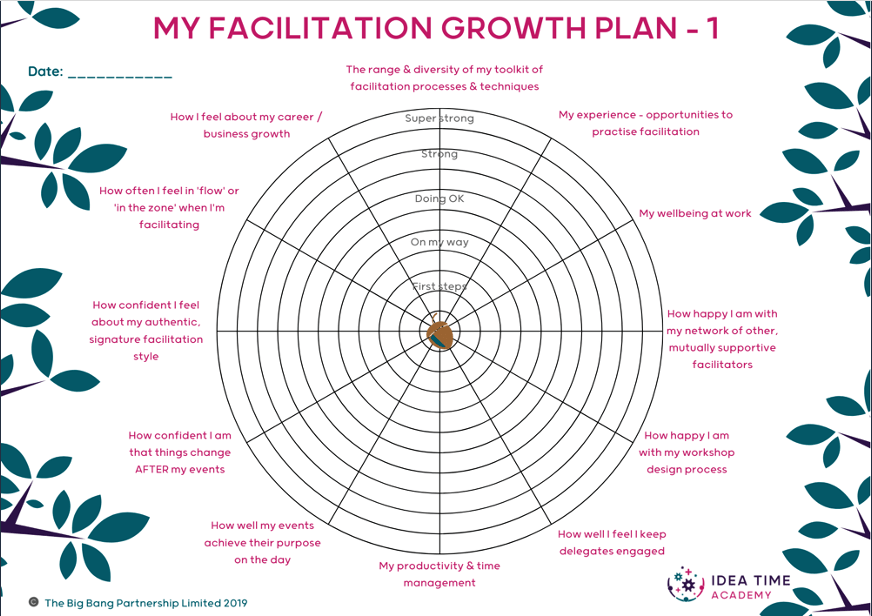
When you look at this later in the year it will be so cool to have all this recorded and be able to look back on your journey.
The third and final activity for this session builds on your 12 growth plan scores. Use this table here and have a go at using the 5 Whys Root Cause technique to explore your thinking further.
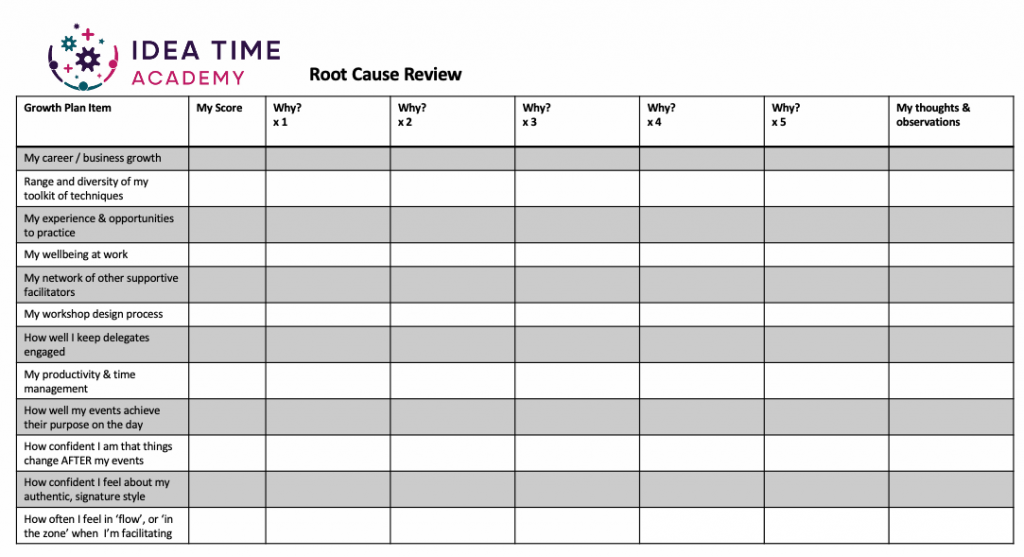
The 5 Whys technique helps you to get to the real root of something really quickly. You can also use 5 Whys for troubleshooting, improving quality, problem-solving or just to resolve simple or moderately difficult challenges. It’s also used in Lean manufacturing and Six Sigma.
For each of the statements and the scores, including those with a strong or super strong score, you’re going to ask ‘why?’ you’ve scored it that way, 5 times, and fill in each space in the table as you go.
Asking why sounds simple, but answering it sometimes requires serious thought. Search for answers that are grounded in fact and think about things that have actually happened. Write them all down.
Ask ‘Why?’ 4 more times, each time responding to what you wrote down for the previous why for that statement.
So, for instance, if you’ve written down your first why for a statement, your second why is about the first response, the third why is about the second response and so on.
A tip is to try to move quickly from one why to the next so that you have the full picture before you jump to any conclusions.
You’ll know when you’ve revealed the ‘root cause’ of your statement when asking why produces no more useful responses and you can go no further.
And just a few other tips while I’m at it – the number 5 in 5 Whys is really just a rule of thumb. Sometimes you may need to ask why a few more times before you get the real root, in other cases you may reach this point before you ask your fifth why. If you do, make sure that you haven’t stopped to soon.
When you’ve written down all your Whys, think about what this means for you and just jot down any thoughts you have in the end column.
You will have the opportunity to come back and build on all your work here when you get to session five. These steps are designed for you to your thoughts down as a starting point before we proceed to get into more detail with your facilitation style.
Facilitation Masterclass: Session 2
This session 2 is all about your ‘roots’ as a facilitator.
That means your purpose, values, DNA, learned preferences and well-being.
We’re going to start with purpose, which is also known as your ‘why’. You might have seen Simon Sinek’s famous TedTalk video, How Great Leaders Inspire Action? Simon shows why it’s really important to work out why we do what we do before we decide what we going to do and how we are going to do it.
Now I know that purpose can feel like it’s a really big and important thing, and it is, but doesn’t always have to be.
Purpose works on the macro level, for example, what is the purpose of life overall?
It also works on the micro level – for example, what is my purpose in the context of this specific project, or on this particular day, on this particular meeting?
What we are talking about here, in the context of this session, is your purpose when it comes to facilitation as your profession or as a part of your wider role.
And although, as I’ve said, purpose can feel like a grand concept, it can evolve and change as you grow, like everything else you’ve been working on in this masterclass. So never think that when you’re writing down your purpose, that that’s it – that’s got to be it forever! Not at all.
Know that you can change and evolve it as you change and evolve, and that’s absolutely very normal, healthy and fine.
Here is a step-by-step process for you to think about your purpose as a facilitator and the sort of facilitator you want to be.
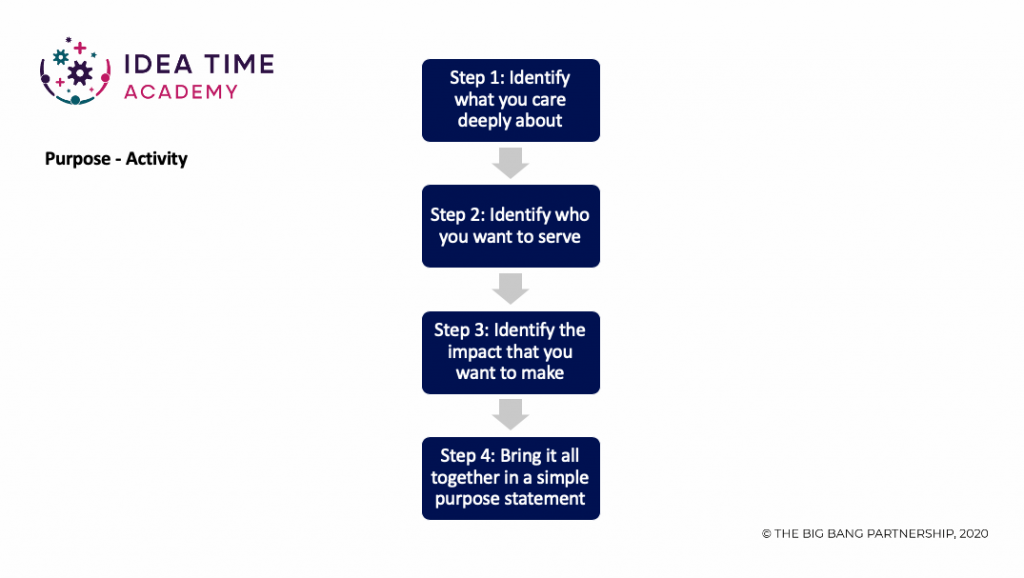
The first step is to identify what you care deeply about. Some people say you should find out what you’re passionate about, but my view is that passion is a strong but often short-lived emotion that can burn itself out or become wearing. Caring deeply is more sustainable in the long-term, and perhaps more meaningful. Write down what you care deeply about, something that has a real sense of meaning. You could draw inspiration from what you’ve done in the past and the things you’ve been most proud of. They don’t have to be big things as long as they are important to you.
The second step is to identify the people who you serve or want to serve. We feel that we have purpose when we are doing things in service of other people. They could be customers, delegates, community members, or supporting bigger societal issues and agendas.
When you think about what is meaningful to you, think about who you are working to help and be really specific about that.
The third step is to think about the impact that you have made, and the impact that you want to make in the future. Write down your thoughts on the impact that you want to have on the lives of the people you want to serve. How do they benefit from all the work that you do? How are you improving things for people?
Step four is to bring everything together into a simple purpose statement. Don’t just think about what you are doing now. I want you to think about how you want to develop and grow beyond where you are now into the impact that you want to have in the future.
Your purpose statement will be constructed like this:
I am here to (insert the impact you want to make) in order to serve (insert the people that you want to serve).
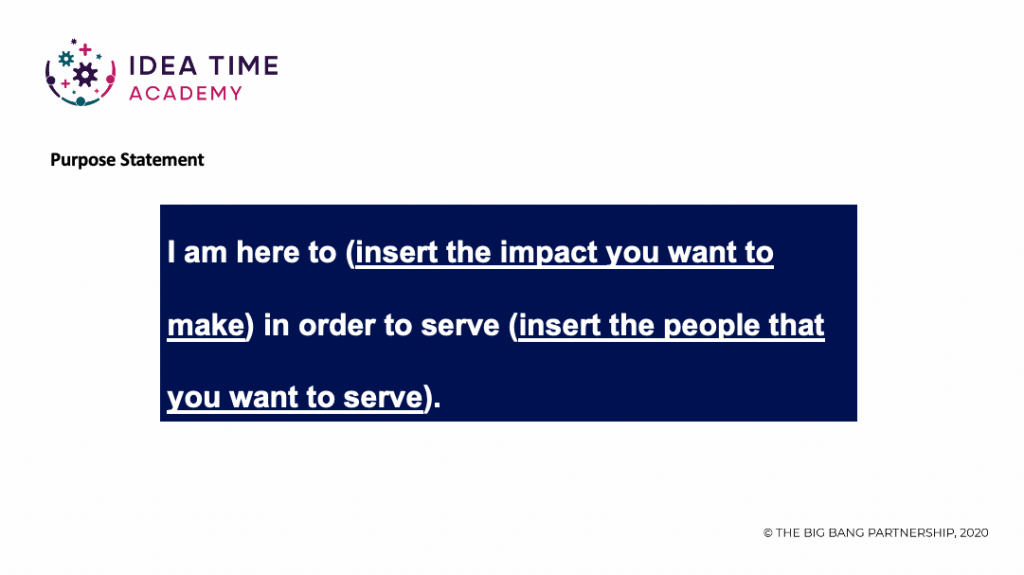
It’s really as simple as that. Remember, don’t overthink it – it doesn’t have to be perfect. It’s more important to make a start. Your brain will be working on it and evolving it even without you noticing. You can shape and finesse it over time. The important thing is that you have something that feels like you’re going in the right direction. If you work with colleagues as facilitation team this is a really nice activity to do together too.
The next phase of exploring the roots of your facilitation style is to be really clear on your values. These are your fundamental beliefs, what you stand for. Values are important for all of us, whatever we do, whether we facilitate or not, because knowing and being consistent with our values can guide us and help us spend time in the right areas.
It’s powerful to align who you are with what you do and how you do it and spend time on work that has real meaning.
I’ve included some example values here, and what I’d like you to do is to pick out the ones that resonate with you the most. Add in any that you think are missing. Mine are just suggestions.
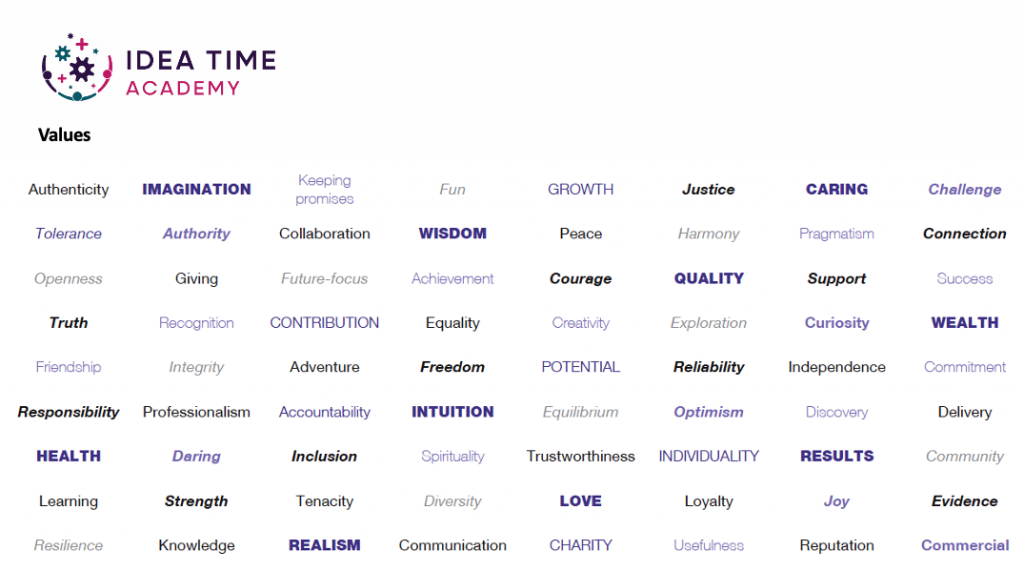
When you’ve highlighted all the values that you think are relevant for you, the next step then is to distil them down to the top five and create your own definition for what each value means to you. Distilling is important. We can’t really remember more than five. and having fewer than five often doesn’t represent the breadth of things that are important to us.
I’ve provided an example here of my values and the sentence or two that describes each one. Mine are customer-centric and written as ‘we’. I usually am in the business working alone but often will bring in associates. I want to make sure that anyone who works alongside me shares those values. How you choose to do it is up to you, of course.
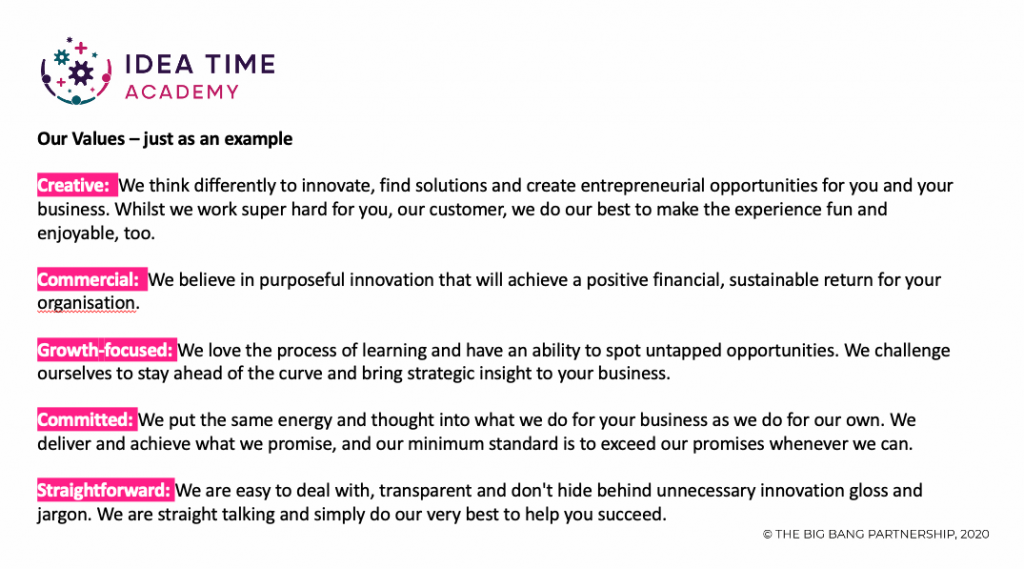
Know Your Preferences
Another important part of your roots are your preferences. Your preferences might be things that you’re born with – in your DNA and part of your genetic inheritance – or learned behaviours and preferences.
There are all sorts of tools available to help you develop your self-knowledge, and I’m sure you’ve used some of them to learn about yourself and identify what your preferences are. A few examples are MBTI, Disc, Foursight amongst many others.
If you haven’t had the opportunity to use many or any of those tools, or if you’ve not used tools such as these for a while, I recommend that you look at a book called Strengthsfinder. It’s based on Gallup research and is very affordable – you can get it from Amazon or other booksellers for about £15 or USD20. When you buy the book it gives you a code in the back which you use to go on their website where you can complete your own Strengths profile and get a really comprehensive PDF based on your responses that identifies your top five strengths with some descriptions and some ways in which you can use your strengths.
A big part of defining and developing your authentic signature style starts with having clarity on your strengths and on how you want to use them.
Think about how you demonstrate your strengths at work, how you communicate them and how you are looking for opportunities to use them.
Your Wellbeing
The final pillar of this is of course wellbeing. There are eight dimensions of wellbeing. Each of them is shown here: work; social; physical; emotional; spiritual; financial; environmental; and intellectual.
Look at those in the round and think about how well balanced and integrated your life is versus what you’d like it to be. Are there any steps that you could be taking to strengthen and any of these areas of well-being?
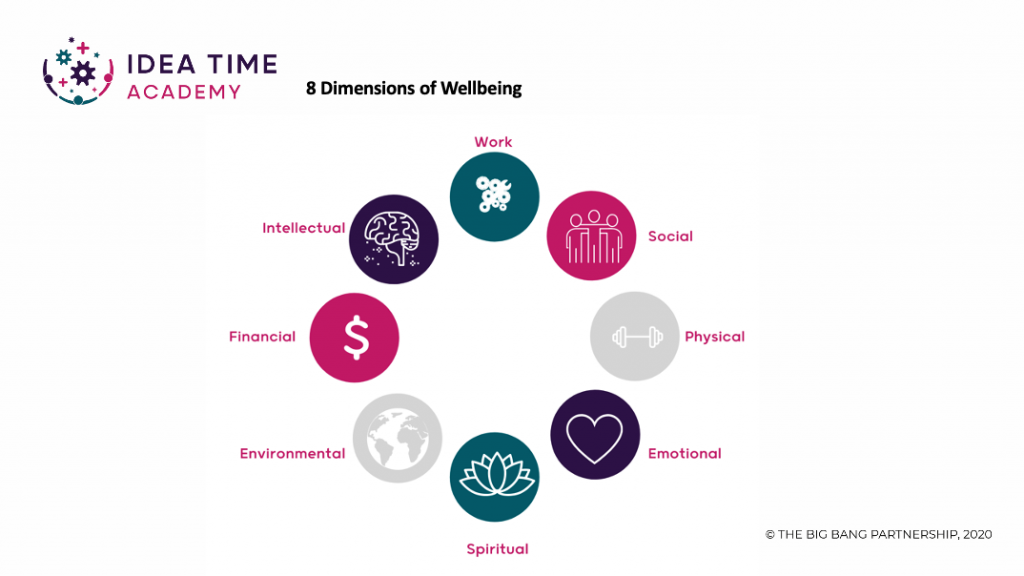
Facilitating from the inside out, bringing our whole, best selves to work means that wellbeing is an essential part of the mix. I know it’s probably the area I find most challenging. I get so into my work I sometimes forget to make the time for enough self-care. That’s something I’m looking to put right going forward.
Facilitation Masterclass: Session 3
In this session we are focused on developing your core – your strength, heart, flexibility, presence, skills and experience.
As facilitators we need to demonstrate the right balance of strength and warmth of heart for the moment we are in. And the right balance of strength and warmth are the magic ingredients of compelling leadership and the x-factor we sometimes call charisma. This is supported by research, for example Neffinger and Kohut in their book, Compelling People: The Hidden Qualities that Make Us Influential.
We need strength to lead the room, challenge the group, give clear direction when we need to and to follow through with our process. We need warmth to engage with delegates, have and show empathy, be good to be around, make connections and more.
Some of the concepts we are thinking about here often seem to be in tension with each other, but when we can get the balance of those apparent tensions right, we get a magical mix of ingredients that can really add value to the facilitation process. Strength and warmth are one of those apparent tensions, and another one is having high self-awareness without being self-conscious.
Another apparent tension is strength and flexibility. As facilitators we need to be strong, organised, have a process and lead from the front. But we also need to be flexible, agile and adaptable.
Sometimes discussions can take a different turn from what we expected. The group might need to spend longer on one thing than they do on another. So, having the strength to drive through the process but also this flexibility to adapt the process to give the delegates space to explore what they need to explore is essential.
I’ve worked with some cracking facilitators over the years, and I’m sure you have too. From my experience – and I’d love to know what you think about this – fantastic facilitators create jazz rather than follow a score.
I think there’s nothing worse than a facilitator who insists on driving people through the process as if it’s a sort of a sausage machine, going from one activity to the other without really tuning into the content, discussion themes and the mood of delegates.
A good design and plan are absolutely fundamental, but sometimes you’ve just got to put the plan to one side, go off a little and come back. Thinking on your feet is a critical skill. Slowing down to think within the moment by pausing really helps.
Emotional Intelligence
Underpinning all of these themes is emotional intelligence, being able to access, interpret, manage and express emotions, and able to relate to others and understand their perspectives. It’s about how we pick up on and empathise with the emotions that other people are feeling and being able to influence others positively and with integrity.
Here are some top tips to help you to develop your emotional intelligence. Select the ones that you think will you the most, mark them with a tick in the box and write your commitment to how you will implement them alongside the tick.
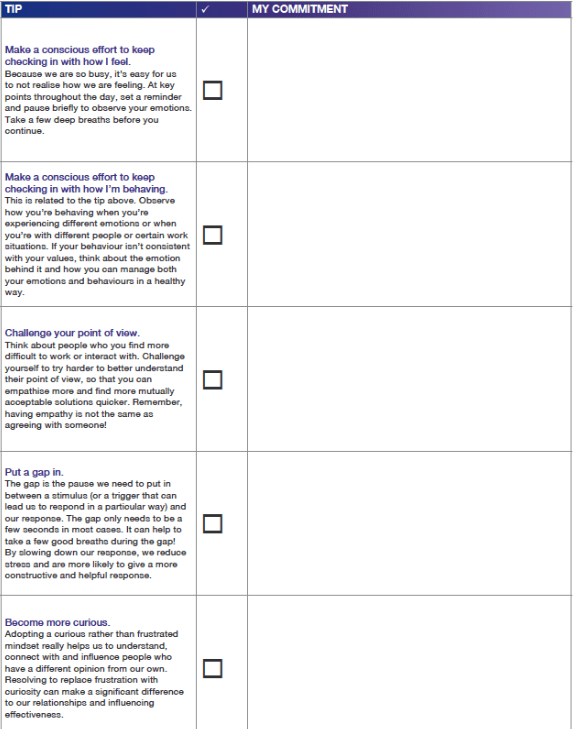
Also reflect on your own emotional needs. I have included some of the most common emotional needs here. There are many, many more.
We all have emotional needs and sometimes when we feel that an emotional need isn’t being recognised, it can ‘trigger’ us to respond or react in a way that is less than ideal.
Of course, unless we are a child or need extra care, the only people responsible for meeting our own emotional needs are ourselves. That is our job.
But as humans we have a legacy of experiences leftover from childhood and throughout life, and that’s where those emotional needs and triggers come.
As a facilitator, being aware of your own emotional needs and triggers can really help you. I’ll give you an example. For me it’s really important that I feel that the work I do is valued and that people know I’ve tried my best, even though something might not be perfect. That’s an emotional need and trigger that I’ve had to work on over my career as a facilitator. If I get the sense that my work isn’t being valued, that might make me more defensive or less engaged or whatever, so I’ve learned to separate that need for my work to be valued from the specific issue at hand, and usually what’s really going on isn’t that somebody isn’t undervaluing my work. They’ve got a different perspective, that’s all. I can be more balanced in my response now.
Of course, I need to make it super clear that if you’re going to work on your emotional needs and triggers and think that it might not be good for you in anyway – for example, issues in here in your past that are deeper than the day-to-day work situations we are discussing here, then you might want to either skip this activity, or do it with some support.
I’ll leave it down to you to decide. You know best of course in terms of what you think will best serve you.
As an aside, the other way that being mindful of emotional needs and triggers works is being able to recognise potential triggers in other people when you’re facilitating.
I think people indirectly give us clues in terms of what they need from us and being receptive to those clues can also help make us a better facilitator. That’s one for another session, but I just wanted to flag it.
Step 1
Identify your emotional needs either from the list below or adding in your own items.
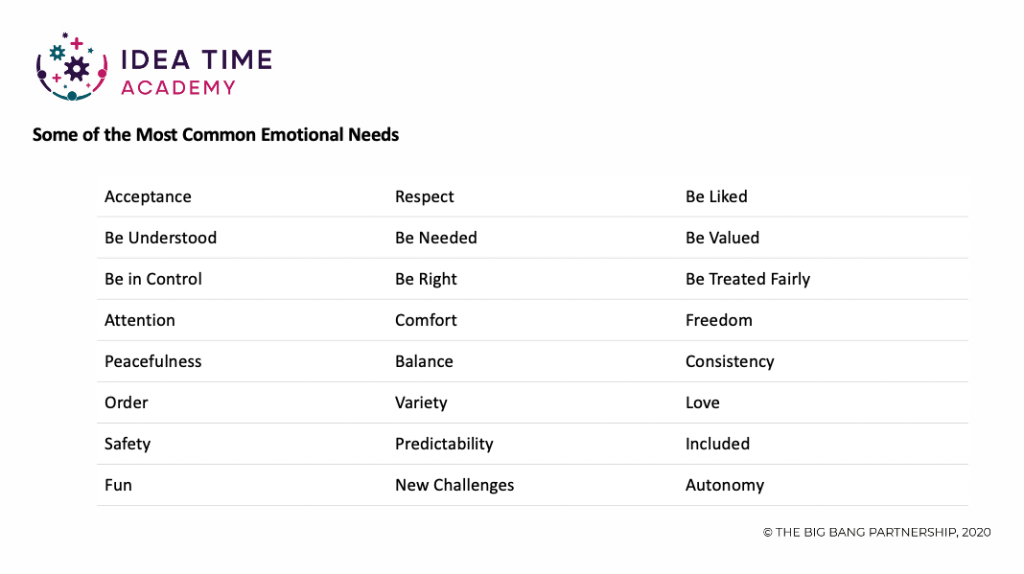
Step 2
Write down what you feel, believe and do when you are ‘triggered’ – i.e. when we have a personal, emotional response to these needs being met. Do this for each emotional need that you’ve identified in Step 1.
For example, how does being triggered affect your judgement, communication skills, learning, empathy and so on. Do you argue, get defensive, go quiet…?
Step 3
The next step is to proactively choose your reaction for if and when you are triggered in the future. Planning a calmer, more productive response is likely to benefit you and others, and it makes it less easy for other people to ‘press your buttons’, deliberately or otherwise!
For each of the emotional needs that you have identified above, make notes here on what you intend to do when you are triggered, and the behaviour you’re going to choose instead.
For example: My emotional need is to be right. When I allow myself to be triggered, I become argumentative and stubborn. Instead, I am going to choose to listen, focus on facts and evidence, and be ok about the fact that I might actually be wrong.
My emotional need is…
- When I allow myself to be triggered, I become…
- Instead I am going to choose to…
- My emotional need is…
- When I allow myself to be triggered, I become…
- Instead I am going to choose to…
- My emotional need is…
- When I allow myself to be triggered, I become…
- Instead I am going to choose to…
Facilitation Competencies
As a facilitator it’s very important that you’re competent in the areas that matter to facilitation.
Here are some headline facilitation competencies for you to use really as a checklist and reminder. They are collaborating with clients, workshop design to achieve objectives and desired experience, developing collaboration and engagement during the event process, leadership to get the target outcomes during the event, self-leadership and role modelling and continuing professional development.
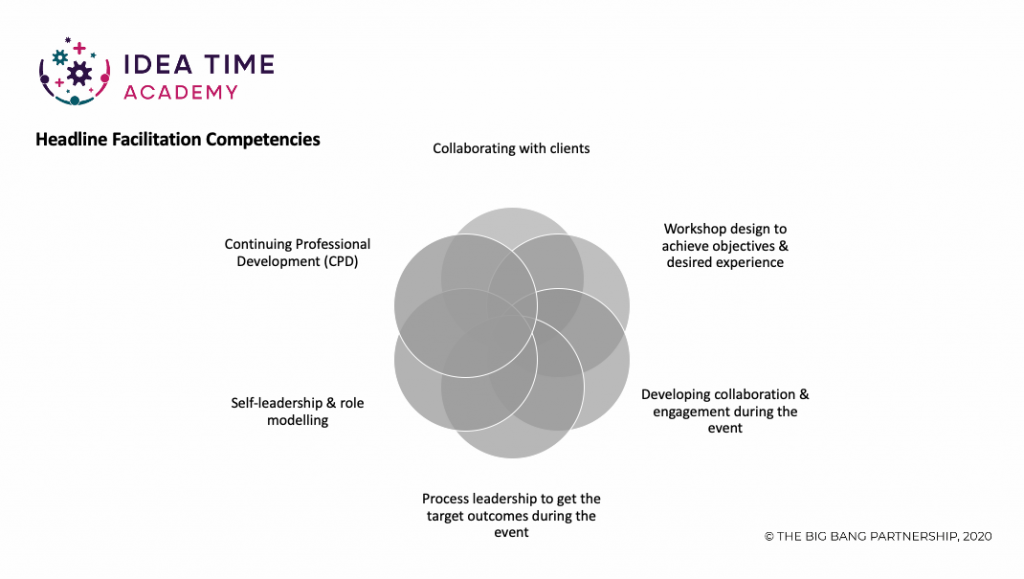
I believe there are many things that are classical and will possibly last forever in the facilitation world.
I also think that as the world changes, so too will facilitation. There are new techniques and approaches, ideas, challenges all the time and it’s a wonderfully exciting profession to be in. That’s what makes continuing professional development so enjoyable.
It’s easy to take for granted that the more we facilitate, the more we learn and the more we grow.
But we only achieve our full potential if we make an effort to really learn from every single facilitation experience that we have.
Self-reflection
There are three types of reflection that you will want to think about if you’re going to develop your facilitation skills and style through professional reflection.
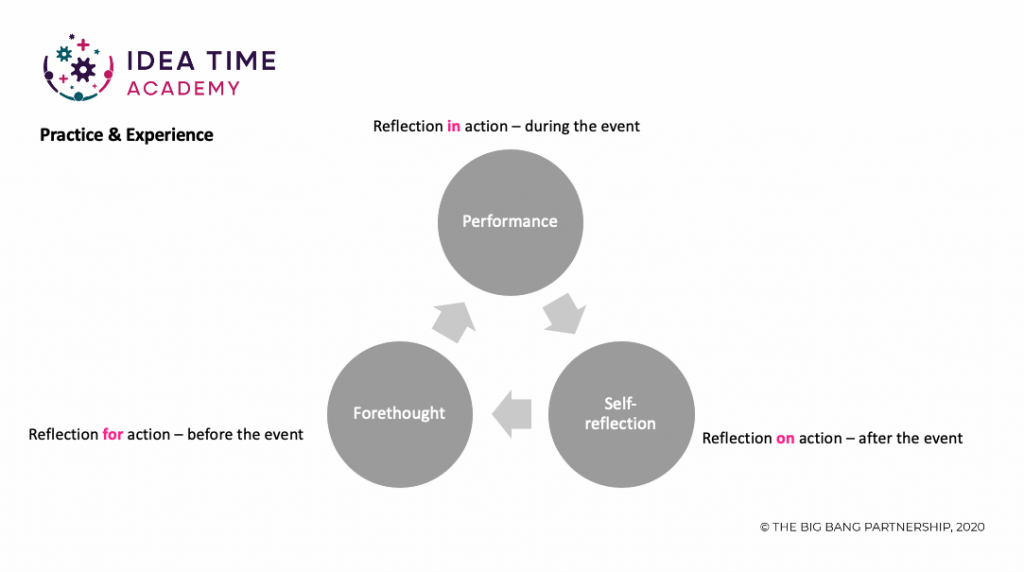
There is reflection for action that happens before the event. It’s where you draw on all your previous skills, expertise, experience of what’s gone before and where you use your imagination to visualise how you want the event to run, and how you’re going to get ready for the event.
The second type of reflection we need to be engaged with is reflection in action. This means that during the event you’re really tuning into how well your processes, techniques, tools are working, how engaged your delegates are and how you yourself are feeling, tuning into your emotional intelligence and make sure that’s all working.
There are countless micro moments during an event in which we’re engaged in reflection in action.
The final one is reflection on action. That’s where we step back after the event to really think through what we’ve learned from it and what growth we can carry forward.
This goes well beyond the standard happy forms and feedback sheets. It’s actually at a deeper, more self-reflective look at how things have gone.
A lot of our growth does come from intuitive insight, and we can strengthen our practice if we also mindfully and intentionally make time to do some deeper reflection and create a positive cycle of reflective learning as a professional.
Facilitation Masterclass: Session 4
We are now going to focus on branches, leaves and fruit.
Our specific theme is developing flow.
I thought I would share this quote to get us started.
“The best moments in our lives are not the passive, receptive, relaxing times . . .
The best moments usually occur if a person’s body or mind is stretched to its limits in a voluntary effort to accomplish something difficult and worthwhile”
(Csikszentmihalyi, 1990)
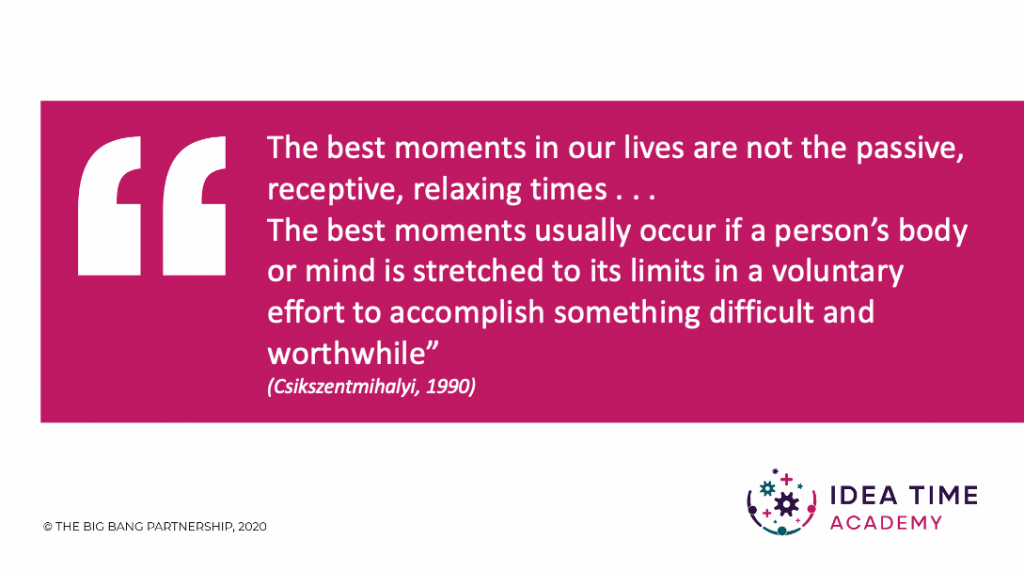
I certainly know that the times I have truly really loved being a facilitator have all been times where I’ve properly been in flow.
I can be in flow when I’m designing, or in a client planning meeting as well as when I’m facilitating. But for me nothing beats being in full flow when I’m on my feet facilitating with delegates.
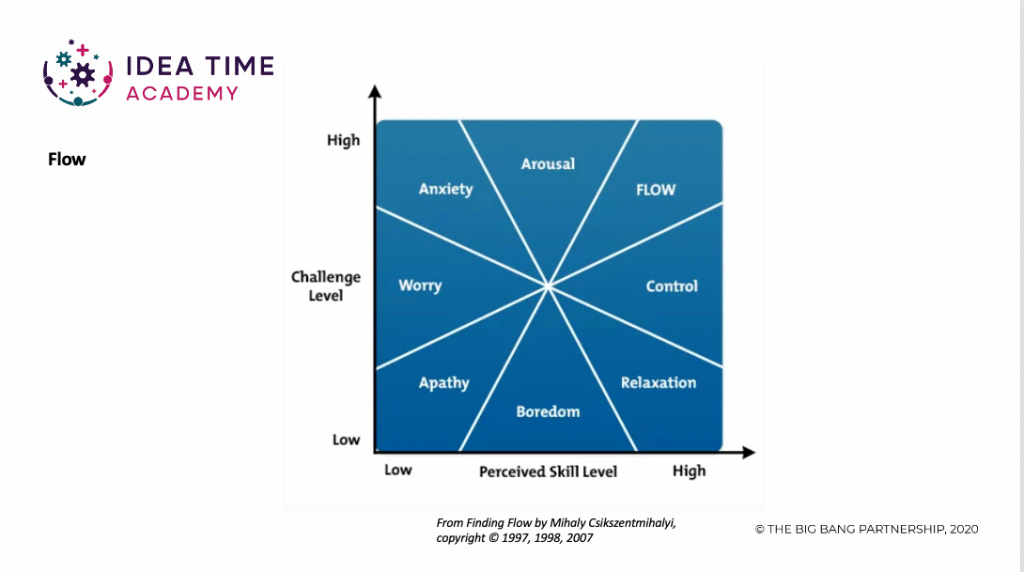
But if it’s more significant than that, and if it continues throughout the event as well, think about what it is specifically that’s driving that anxiety and that worry. Use the 5 Whys technique that we used in session 1 or send me an email and we can talk one-to-one. All that probably means is that you either do have the skills to deal with the situations that you’re in, but you don’t realise it, or that there is some skills development to be done. Both are very fixable.
I’m really happy to talk that through with you.
So essentially to stay in flow it’s about keeping the right level of challenge to appropriately stretch your skills.
The universal factors of flow that happening are:
- Action and awareness merging. That’s where we’re not thinking through our actions. A good example is when the learning to drive. If you think about when you very first got into the car to drive, how hard you had to think and concentrate to manage the controls, change gear, steer and all of those things. Once you become a more proficient driver, your awareness and actions merge.
- Clear goals help with flow because they help us with a target outcome to focus on.
- Unambiguous feedback is a great one. The wonderful thing about facilitating is that you actually you know how it’s going and how you’re doing in each moment if you are highly emotional intelligent and able to read the room. And if you’re unsure and ask, your delegates will surely tell you!
- Concentration on the task in hand and a sense of control mean that you’re super focused and in the zone. It doesn’t mean you’re controlling everybody and everything, but it is rather the sense that things are under control for you and you’re not self-conscious in anyway. You are just really into what you’re doing.
- You’re absorbed in the moment, so time seems to fly by and standstill all at the same time.
- You’re also enjoying facilitating just for its own sake, to be in that experience – it’s autotelic.
Here are some statements for you to think about. Try to think about them in relation to a specific, recent facilitation experience that you’ve had.
The more strongly you agree with each one, the more likely it is that you will have been experiencing flow.
1. I was challenged, but I felt that my facilitation skills would allow me to meet the challenge.
2. My attention was focused entirely on what I was doing.
3. I really enjoyed the experience.
4. It was no effort to keep my mind on what was happening.
5. I was not concerned with how I was presenting myself.
6. The challenge and my skills were at an equally high level.
7. I did things spontaneously and automatically without having to think.
Factors that Help and Hinder Your Flow
The next activity is to reflect on factors that help and hinder you being in flow when you’re facilitating.
Then think about how you can build on the factors that help you even more and be in flow even more often.
And also think about how you can minimise, get around or remove the factors that hinder you from being in flow. Use the table to below to capture your thoughts.
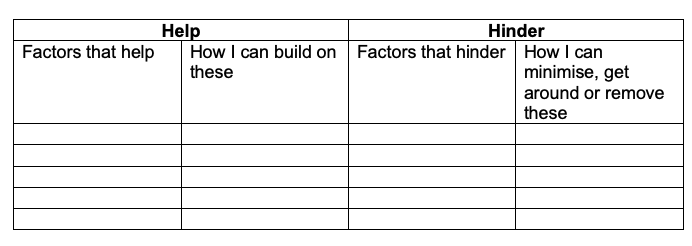
And I really like this final activity for this session.
I would absolutely love to hear how you get on with it!
It’s the movie activity. This involves finding some quiet time and playing back in your mind a recent event that you were facilitating – specifically a part of it when you were experiencing flow.
I want you to play the experience back in your mind as if you are watching yourself in a movie, so see it from the perspective of someone else observing you in action.
Make some notes or sketch what you think the other person would be seeing, hearing and sensing about you.
You will use these inputs to put everything together in the next and final video. You’re doing some deep work that a lot of facilitators don’t do. It’s okay to work at the surface and that will get results, but actually thinking about yourself from the inside out and working as your whole best self will really pay dividends.
Facilitation Masterclass: Session 5
Well, this is exciting! A big high-five and well done – you are on the final session of how to develop your awesome, authentic signature facilitation style masterclass.
In this one we are really reviewing and the work that you’ve done so far and putting it all together in during all those threads across so that you can actually have a really clear view of what your awesome, authentic signature style is.
What I’d like you to do after you’ve watched this super short video is a quick series of activities. The first of these is to actually go forwards by going backwards!
I’d like you to revisit the work that you did from session 1 where are you defined your authentic signature facilitation style.
Do you remember collecting words that you think describe you from your own perceptions, and those of your colleagues, clients, delegates and so on? You may even have created a word cloud of those keywords. I’d like to go back to that and see what, if anything, you would now add, change, develop or reword given all the work that you’ve done so far. Go through your notes of all the different activities and then go back and update that activity.
I’d also like you to revisit your Facilitation Growth plan and your Root Cause Review. Revisit and refresh them. You’ll notice there is also a new column for actions in your Root Cause Review below for you to complete now, too.
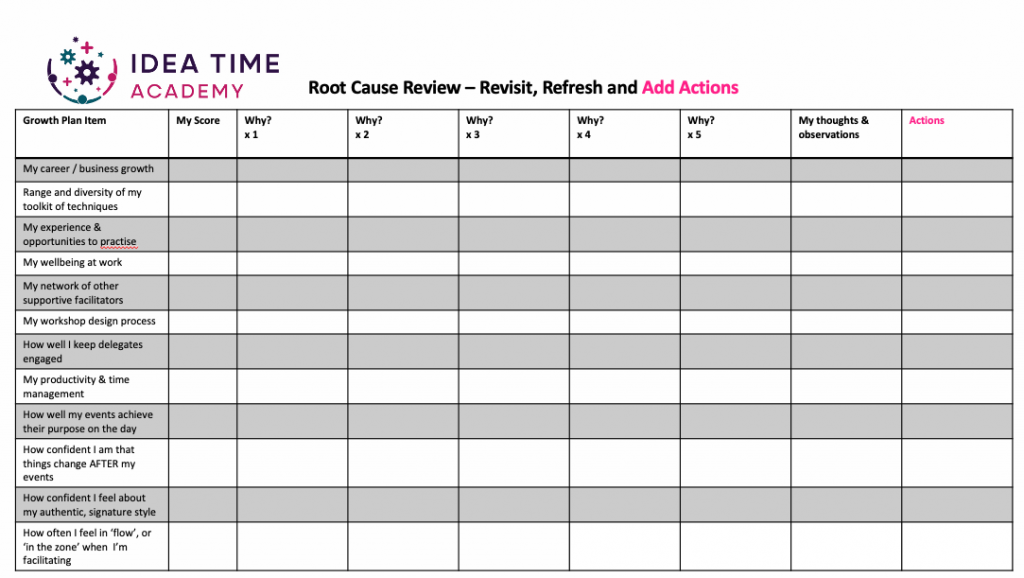
Add in actions that you want to take to use all of your learning and insight forward from this article. How are you going to leverage it and take yourself to the next level?
Final Challenge
Finally, I have a challenge for you. And there is a fun, creative and useful prize if you do this activity and send it to me!
I’m looking forward to seeing yours!
Your challenge is to define your awesome authentic signature style as if you’d be posting it as your profile on one of these social media platforms – Instagram, Twitter, Facebook or LinkedIn – and you need to do it using no more than the number of characters that the platform currently allows, which you can see in the slide.
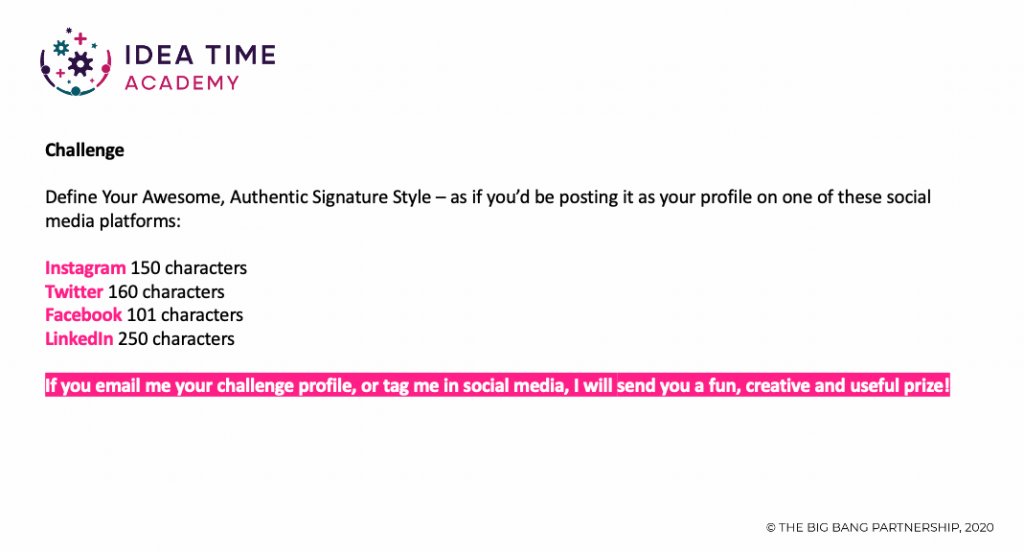
Congratulations!
So that’s it! That’s the end of this masterclass! A huge well done and congratulations for coming this far and for all your great work.
I would love to hear what you think, so please do email me to let me know how you’ve got on. I’d love to see your work, so do share some of your stuff with me, it’s all confidential. I am looking forward to hearing from you! Bye for now.

